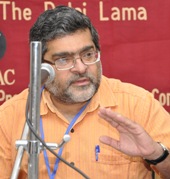Public Lecture
Gandhi and the Politics of Visual Representation
Time: 5:30pm to 7:30pm
Location: Cal Poly Pomona, Bronco Student Center, Ursa Minor
Event Flyer

Vinay Lal
Vinay Lal earned his Ph.D. with Distinction from the University of Chicago in 1992 after undergraduate and masters degrees in literature and philosophy from Johns Hopkins University. He has taught history at the University of California, Los Angeles (UCLA) since 1993 and most recently was Professor of History at University of Delhi (2010-11). His dozen books include Deewaar: The Footpath, the City, and the Angry Young Man (HarperCollins, 2011); Political Hinduism: The Religious Imagination in Public Spheres (ed., Oxford, 2009); The Future of Knowledge and Culture: A Dictionary for the Twenty-first Century, co-edited with Ashis Nandy (Viking Penuin, 2005); Of Cricket, Guinness and Gandhi: Essays on Indian History and Culture (Penguin, 2005); The History of History: Politics and Scholarship in Modern India (Oxford, 2003); and Empire of Knowledge: Culture and Plurality in the Global Economy (Pluto Press, 2002). His work has been translated into Hindi, Urdu, Kannada, French, German, Spanish, Finnish, Korean, and Persian. He is also honored to have been profiled at some length in David Horowitz’s book, The Professors: The 101 Most Dangerous Academics in America (2007).